A week of Supergirl! I’m in heaven. Not only did Supergirl return on the CW this week, issue three of DC’s four issue miniseries Supergirl: Being Super dropped on Wednesday. And it was just as good as the last one. Though unrelated to the Arrowverse’s TV adaptation of Supergirl, this Kara Danvers still feels familiar and beloved to me. These comics continue to capture those facets of Supergirl I love best—her heart, compassion, strength in the face of adversity, and willingness to sacrifice for the ones she loves—while offering new, fascinating insight into her character and history.
As with last issue, in order to fully unpack everything Tamaki and Jones have accomplished in this issue, I’ll need to get into spoilers. So if you haven’t read it—and if not, I’ve been failing at my job—go read it, then come back and flail with me in the comments. I’ll be waiting.
Why pick this up?
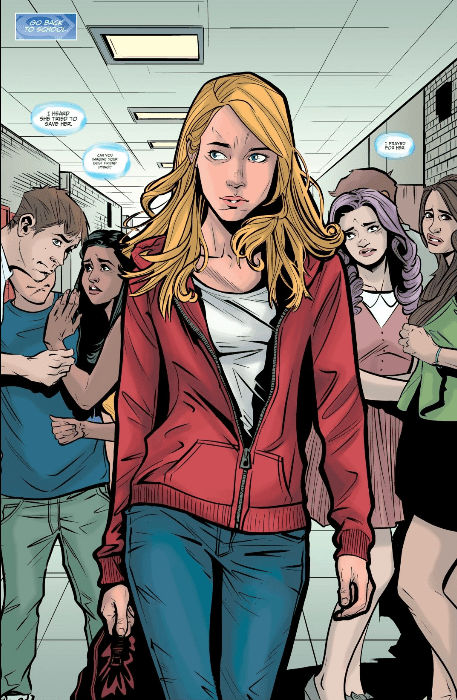
I could gush all day about the dynamic duo that is Mariko Tamaki and Joëlle Jones. In my mind, Kara Danvers exists as Jones draws her; she so perfectly captures both Kara’s dynamic, boundless energy, and her slouchy teen gangliness. Her bold use of lines to demarcate Kara’s emotions and moods is damn impressive. Just look at how the image above creates a sense of distance between Kara and those around her. She stands out from the crowd just as she feels she stands out among her peers.
This issue focuses more on the mystery surrounding Kara’s loss of powers and the recovery of her memories of Krypton. However, it never loses sight of the grief and loss explored last issue, both of which hover in the background and lend depth to Kara’s already tumultuous feelings about being an alien. The use of pacing and momentum sets up the final confrontation well without losing sight of what precipitated everything: the earthquake and Jenny’s death. Throw in emotional flashbacks and moving scenes with family and friends and my pathos can’t even handle it. Only it can, because I am here for all of this.
What I Loved
I cannot get enough of Jones’ art. For serious. She’s a master of conveying and mirroring character’s emotions in a physical way. I’ve been a fan of the color since the beginning, but Kelly Fitzpatrick’s skill with palette and tone stood out this issue even more given the more frequent flashbacks. I love the use of sepia for the flashbacks, as it visually conveys ‘past’ without having to resort to textual cues like “10 years ago”. Precise time matters less than the emotion expressed in the color choice, or so it seemed to me.
Brown hues are warmer than, say, black and white. The choice adds a note of nostalgia and positive emotional association to Kara’s memories, many of which are traumatic. I, for one, adore the cognitive dissonance involved by juxtaposing warm hues with distressing memories. It mirrors the ambivalence one would expect from the situations she’s recollecting. Honestly, Fitzpatrick and Jones are so in sync here with the art that it works better to show you how compelling their work is.
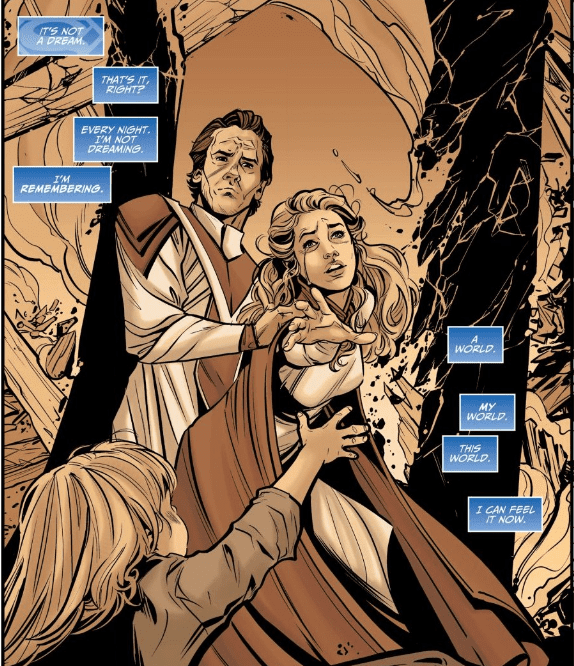
Before I move on to the main plot, which is fantastic, I want to gush a bit more about Dolly. She’s absolutely perfect as a best friend for Kara. The difference in how she processes her grief and reacts to her parents highlights that not everyone grieves the same way. She makes nerdy T-shirts, gripes about how pointless school is, yells at assholes, and eats her feelings. I may be biased because half of these are things I do when I’m overwhelmed, but still. She feels real to me, and she grounds Kara as a character, who could easily feel to distant from humanity given her alien nature.
Instead, Dolly offers her unconditional acceptance. I can’t tell you how masterful a writing choice that was. The gift of wholehearted support and acceptance coming from a queer girl of color? A+ writing, Tamaki. It only makes Kara ghosting Dolly to try and protect her that much more of a sucker punch to the gut.
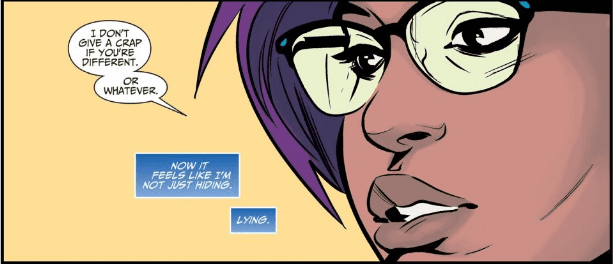
Speaking of A+ writing, Tamaki blew me away once again. She manages to touch on the difficult subject of Kara’s fear of losing love because she’s different without it feeling either cheap or appropriated. The visual echoes between flashback and present drive home how events in Kara’s past have wrapped up the need for secrecy the fear of being sent away or misunderstood. She may outwardly fit a certain stereotype or beauty standard, but Kara embodies the experience of teen alienation (heh). And not in an annoying “hot girls, we have problems too” kind of way.
Nowhere is this more realized than in the intertwining of her loss and mysterious alien past. She’s continuing to process her grief about Jenny’s death while also being unsure of who she is. It’s a lot for Kara to deal with. Dialogue like “only so much I can fit in my brain” or “crawling out of my skin” capture well an emotional head space that can be difficult to verbalize.
And the two experience feed off of and into each other throughout the story. It’s a completely new way to explore the tension between old life and new. Tamaki frames the loss of Kara’s old world in terms of loss in the new, the loss of her Kryptonian family (and fear of loss/danger to her human family) in terms of the loss of a human best friend. Small wonder, then that Kara makes such an impulsive decision as to go off with a boy she’s only just met.
The level of sympathy Tamaki has for Kara’s situation leaps off the page. It rubs off on the reader, too. You’d be hard presse to not empathize with Kara’s emotional state or choices. Kara’s always been different, alien. Now, she’s grieving, which is a vulnerable place to be. She then finds out her track coach, a woman she looked up to, is experimenting on her and the only other member of her species she’s met on earth. Of course she’s going to want to go with him, to be with him. He’s the only piece of her old home, the home she only just recently remembered, that she has left.
She’s also a teenager. She has had grief upon grief: the loss of her friend coupled with a renewed memory of the loss of her parents and planet. She’s reaching out to the only piece of her past life in front of her, unaware that the person she’s reaching out to has been seriously emotionally compromised by his own trauma.
When we are most vulnerable, we go back to what we know, to the oldest patterns and memories. It’s unsurprising, then, that her memory of her old life on Krypton returns when in the midst of the chaos that is the wake of Jenny’s death. Tamaki has taken an normal part of human psychology and transmitted it on page in a fresh, breathtakingly beautiful way here. It normalizes the experience of loss, generates sympathy for a hurting girl’s impulsive behavior, and all while honestly exploring the various feelings that come with loss.
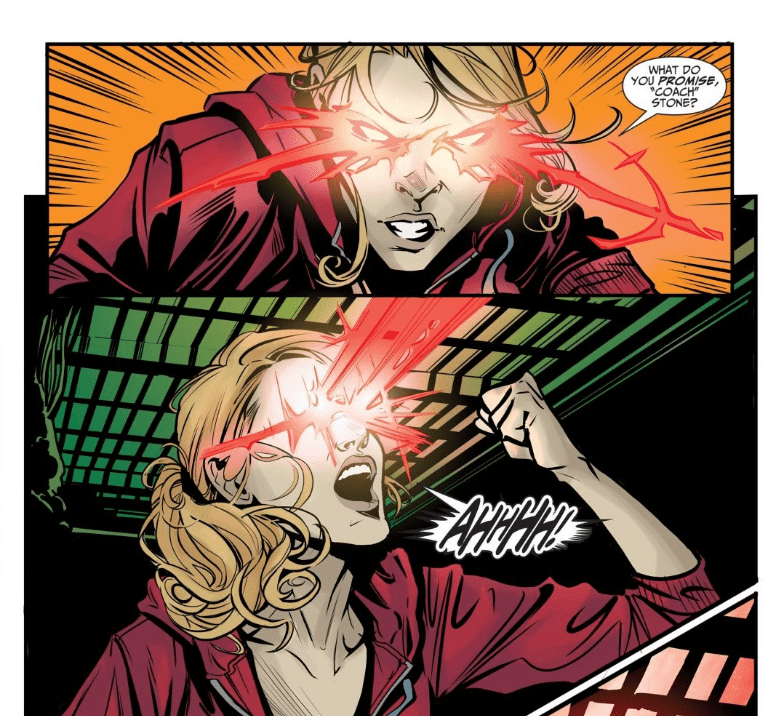
That Kara discovers her heat vision in a moment of rage-filled betrayal makes perfect sense. How raw, how honest, how real is this? I love it. And not just because it reminds me of Red Kryptonite. I love the complexity behind it all. Yes, there’s anger at Coach Stone’s betrayal and lies; Kara’s heat vision dramatically encapsulates the feeling of wrath the situation would create. But also because of the layers of grief and fear laced into the situation as well. We just saw flashbacks of Kara saving her grandfather and his statement that she ought to be reported to ‘the authorities’. Thus, mixed in with rage is the fear that discovery will lead to her being taken away and no longer having a home on earth.
If it feels a bit chaotic, it should. Loss brings with it many mixed, sometimes contradictory, emotions that interact in complicated ways. And Kara isn’t just living through one loss, she’s living through multiple. Best friend, home, planet, parents—she’s lost a lot and is facing down even more. She’s only just recovered her memories and then finds herself having to choose between Earth and Krypton, adopted family or species of origin. There’s a lot boiling beneath that surface. All of it’s earned in the narrative. All of it’s sympathetic and nuanced.
On top of this are all the other little delicate touches to the writing that never fail to delight me. Like Coach Stone flipping the script on Kara by telling her that she’s pretending to be human, when really she’s a confused teenage girl who doesn’t know who she is, so how can she lie or pretend? Or how well Tamaki handles Kara’s ‘fish out of water’ vibe with regard to her past while also still knowing her name, language, and elements of her history once prompted. Tamaki has a way with words that is both lyrical and yet still faithful to a teenage girl’s voice.
“All this time I was worrying about not knowing who or what I was…when it’s this world that’s a stranger.”
Plus, Tamaki knows how to sprinkle in humor to lighten the mood without being too jarring or undermining the weight of Kara’s experience. Kara’s joke that all she needs is a “dorky pair of glasses” deserves kudos for being meta. So does her “some stupid girl in some stupid movie” line.
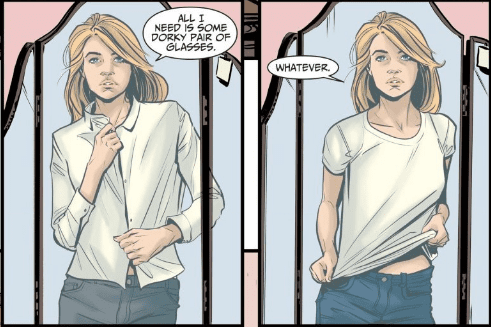
I also love seeing continuities like Kara having this inborn impulse to help people regardless of potential danger to herself. Even as a child she was willing to risk injury to rescue people, long before she would have been aware that her powers set her apart. Touches like that remind me just how well Tamaki knows her character. They’re such warm blanket moments because it’s everything I love most about Kara Danvers.
Oh, I gotta say I’m excited to see what happens with Tan-On. Even here, Tamaki creates a level of empathy for him that I appreciate. We may not agree that his hatred for all humanity is justified, but we can sympathize with his impulse given how much torture he would have undergone at Coach Stone’s hands. (Speaking of which, the choice to make the experiment about renewable energy worked well.) Jones and Fitzpatrick’s art and color vividly depict how the experimentation has sickened him, body and mind. Poor Kara doesn’t know what she’s getting into, but I do hope she can help him find healing instead of revenge.
All in all, for a third issue in a four arc series, this did not at all feel like the ‘curse of the second book in a trilogy’. It sets up the final crises while being engaging in it’s own right. Tamaki paced the series flawlessly. I never once felt this issue dragging or running too far ahead. We’re given just as much information as we need at the time while still feeling drawn inexorably toward the climax. The balance of action and reflection never fell too far on one side, for me, and I was engaged right to the end.
God. I’m just…can I help it if the only thing I can think to say is that I’m super impressed? It’s like sinking your teeth into a chocolate from a box and finding out it’s your favorite flavor. Then doing it again. And again. Only to find out the whole box is filled with all your favorites and you’ve just spent the last half an hour in utter bliss. Oh, and to top it all off, you don’t feel sick to your stomach and the calories didn’t matter. That’s how perfect reading this comic is.
Some Nitpicks
Once more, I am completely bereft of nitpicks. This series takes my breath away and is utterly flawless.
Is it worth continuing?
10/10. So much love for the continued exploration of grief and the way in which Tamaki and Jones juxtapose Kara’s past and present experience. All that and a major cliffhanger? I’m already dying in anticipation of June 28th!
The TL;DR
Wholeheartedly Approve
- flawless marriage of art and writing (yet again)
- use of flashbacks to unify Kara’s past and present experiences
- masterful interweaving of grief, loss, and Kara finding out about her past
- Dolly
- balance of action and emotional weight, excellent pacing, great set up, fascinating characters and themes
Eh, I Could Do Without It
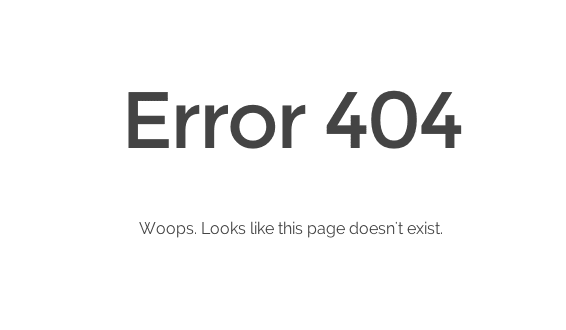
Images Courtesy of DC Comics
Supergirl: Being Super 2 Credits
Writer: Mariko Tamaki
Artist: Joëlle Jones
Colorist: Kelly Fitzpatrick
Letterer: Saida Temofonte
Cover: Jones & Fitzpatrick

